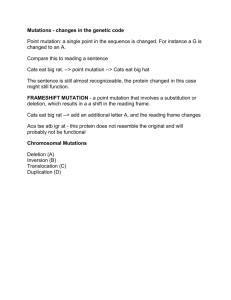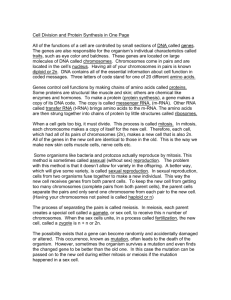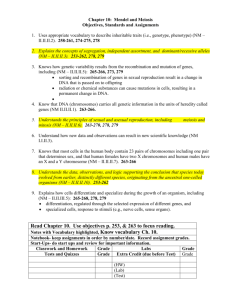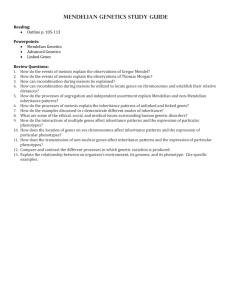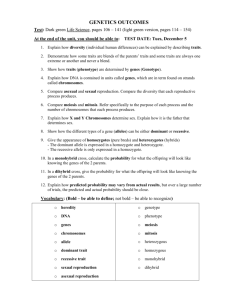Characteristics of Living Things (Essay
advertisement
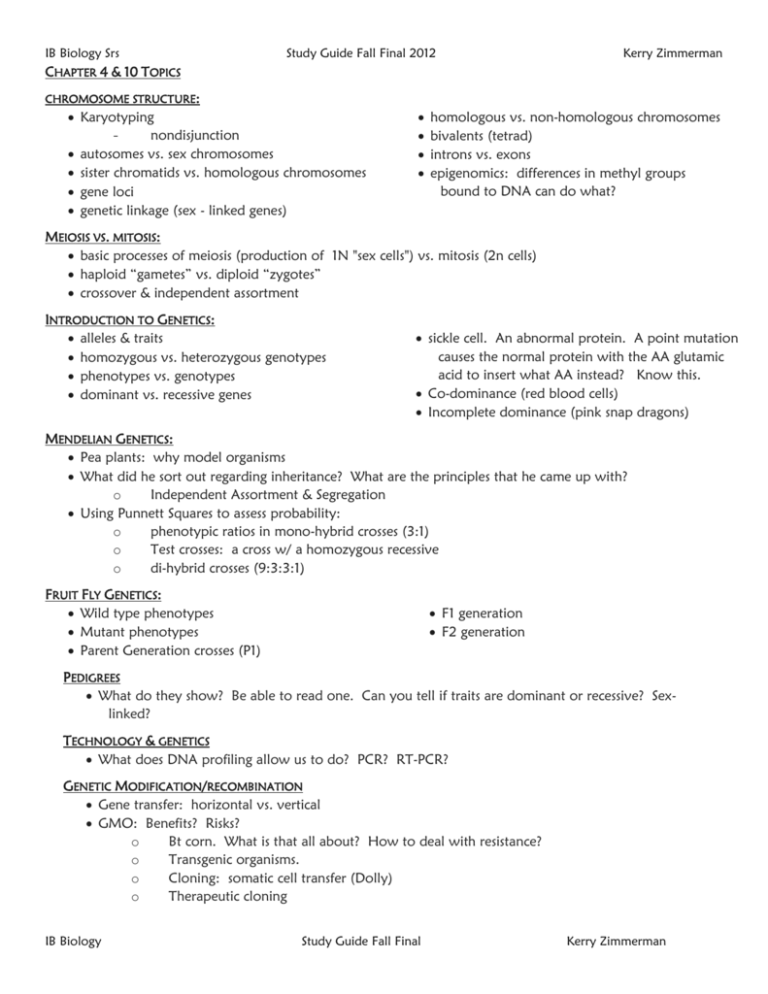
IB Biology Srs Study Guide Fall Final 2012 Kerry Zimmerman CHAPTER 4 & 10 TOPICS CHROMOSOME STRUCTURE: Karyotyping nondisjunction autosomes vs. sex chromosomes sister chromatids vs. homologous chromosomes gene loci genetic linkage (sex - linked genes) homologous vs. non-homologous chromosomes bivalents (tetrad) introns vs. exons epigenomics: differences in methyl groups bound to DNA can do what? MEIOSIS VS. MITOSIS: basic processes of meiosis (production of 1N "sex cells") vs. mitosis (2n cells) haploid “gametes” vs. diploid “zygotes” crossover & independent assortment INTRODUCTION TO GENETICS: alleles & traits homozygous vs. heterozygous genotypes phenotypes vs. genotypes dominant vs. recessive genes sickle cell. An abnormal protein. A point mutation causes the normal protein with the AA glutamic acid to insert what AA instead? Know this. Co-dominance (red blood cells) Incomplete dominance (pink snap dragons) MENDELIAN GENETICS: Pea plants: why model organisms What did he sort out regarding inheritance? What are the principles that he came up with? o Independent Assortment & Segregation Using Punnett Squares to assess probability: o phenotypic ratios in mono-hybrid crosses (3:1) o Test crosses: a cross w/ a homozygous recessive o di-hybrid crosses (9:3:3:1) FRUIT FLY GENETICS: Wild type phenotypes Mutant phenotypes Parent Generation crosses (P1) F1 generation F2 generation PEDIGREES What do they show? Be able to read one. Can you tell if traits are dominant or recessive? Sexlinked? TECHNOLOGY & GENETICS What does DNA profiling allow us to do? PCR? RT-PCR? GENETIC MODIFICATION/RECOMBINATION Gene transfer: horizontal vs. vertical GMO: Benefits? Risks? o Bt corn. What is that all about? How to deal with resistance? o Transgenic organisms. o Cloning: somatic cell transfer (Dolly) o Therapeutic cloning IB Biology Study Guide Fall Final Kerry Zimmerman IB Biology Study Guide Fall Final 2012 SIB LINKED GENES depends on the distance between the genes on a given chromosome If linked, then the genes (and their alleles) are inherited together. o Ex. Flower color & pollen shape If linked, then don’t produce 9:3:3:1 ratio for dihybrid crosses SEX-LINKED GENES Involves genes located on one of the sex chromosomes Ex. Fruit fly eye color POLYGENIC INHERITANCE Involves genes located on one of the sex chromosomes Multiple genes results in an # of genotypes & phenotypes Continuous (ex height) vs. discontinuous variation Examples: Eye color and o Skin Color: continuous variation Melanin: eumelanin vs. pheomelanin UV stimulates melanogenesis: tanning UV initiates vitamin D3 production from dehydrocholesterol Cellular Respiration: (overview stuff from Chapter 3). Part I. Anaerobic Respiration Glycolysis (where does it happen? what is the result?) What is lactic acid (when might it build up on muscles?) Part II. Aerobic Respiration Pyruvate > Acetyl CoA (oxygen present!) (Link reaction? where does this occur?) Krebs cycle...Acetyl CoA plus 4 Carbon Oxaloacetate > 6 carbon Citrate o What important molecules are produced here? Where does this cycle occur? Electron Transport Chain (H+ Buildup!! ADP turns into ATP via ATP Synthase) Where? Photosynthesis: Main products of the light reactions vs. The dark reactions Where do they occur? Effects of changing: temp, light intensity, carbon dioxide Chapter 6 Human Health & Physiology Digestion: pathway. Examples of secretions (& functions) along the way? Mouth . Pharynx. Esophagus. Stomach. Small & Large Intestines. Accessory structures: Gall Bladder. Pancreas. Liver Transport/Circulatory System: -Heart & Blood Vessels (veins/arteries/capillaries) * how does the pulmonary circuit differ from the systemic circuit? *how are the SA & AV nodes involved in regulating the “myogenic contractions” in cardiac tissue? *how do arteries, veins, and capillaries differ in both structure & function? Gas Exchange/Mechanisms of ventilation, -Lungs (structure of an alveolus) -diaphragm/abdominal IB Biology Study Guide Fall Final 2012 SIB IB Biology Study Guide Fall Final 2012 SIB Aspects of the Nervous System: Central vs. peripheral sensory neuron (pressure, temperature) vs. motor neuron/neuro-muscular junction structure and function of neurons: axons/dendrites/myelin ”resting potential” vs. “action potential”: difference in polarity (charge across the membrane) ESSAY QUESTIONS : Essay #1: Part a. In meiosis specifically, what are sister chromatids? How are they fundamentally different from homologous chromosomes? (be very specific and include a discussion of alleles types at different gene loci) . What is an allele? Explain the processes of “cross over” and “independent assortment”, and how these two factors are fundamentally important to variation between gametes that ultimately produce unique offspring? Finally, explain the genetic differences between “daughter cells” produced as a result of mitosis and sex cells produced as a result of meiosis, and discus why a genetic mutation occurring during meiosis in a sex cell will have a more significant affect on an organism overall that a mutation occurring during mitosis in a somatic cell. Part b. compare & contrast with mitosis. Similarities? Differences? What is the role of each? Essay #2 Part a. What is the difference between an organism’s genotype and it’s phenotype. Specifically, compare dominant traits with recessive traits. Explain how an organism can be either heterozygous or homozygous for an allele at a given loci. Also, what is the difference between incomplete dominance and co- dominance - please provide an example of each! Additionally, what is the purpose of a punnett square and how do they help us arrange alleles randomly (the way they may be assorted independently during meiosis). And, what is the difference between autosomal & sex chromosomes? Part b. Assume the following two parent fruit flies ( P -generation) are allowed to mate: *Male (homozygous recessive for sepia eyes) *female (homozygous dominant for “wild type” for red eyes ) What possible genotype(s) and phenotype(s) will be expressed in the F1 generation? Specifically, is it possible for a recessive phenotype to come forth in the F1 generation? What possible genotype(s) and phenotype(s) will be expressed in the F2 generation? Part c. Let’s assume we counted up and observed the phenotypes of 300 of these fruit flies in this F2 generation, and found that their phenotypic ratios closely follow Mendelian predictions of a monohybrid cross. Let’s also assume none of the alleles are sex-linked (in other words, they assort totally randomly). What are the expected phenotypic ratios for a monohybrid cross? What are the expected phenotypic ratios for a dihybrid cross? -How many of the total 300 would you expect to possess red eyes? -How many of the total 300 would you expect to possess sepia eyes? IB Biology Study Guide Fall Final 2012 SIB IB Biology Study Guide Fall Final 2012 SIB Essay #3 Part a. What are enzymes made up of? Why are they described as molecules that catalyze chemical reactions inside of living organisms? How do we - as members of the kingdom animalia, benefit directly from the activities of these incredible little molecules? please provide a specific example (research a chemical reaction that happens inside of us - for example metabolism of some important substance). Part b. We’ve discussed mutations in class. In general what is a genetic mutation and how do they affect enzymes. Think of the hemoglobin gene. What happens to cause sickle cell? What kind of mutation? A change in a specific amino acid? What does Sickle cell anemia cause to happen? Why? (Hint: focus attention on hemoglobin protein and what happens to it as a result of the mutation) Part c. In a recent lab we analyzed the catalase enzyme. What chemical reaction does catalase mediate? In other words what substance does catalase break down? What are the end products? Most importantly, what was the overall purpose of the lab? In analyzing the raw data from the experiment, what did we discover about catalase? (hint: what was the independent variable of the lab?) IB Biology Study Guide Fall Final 2012 SIB
